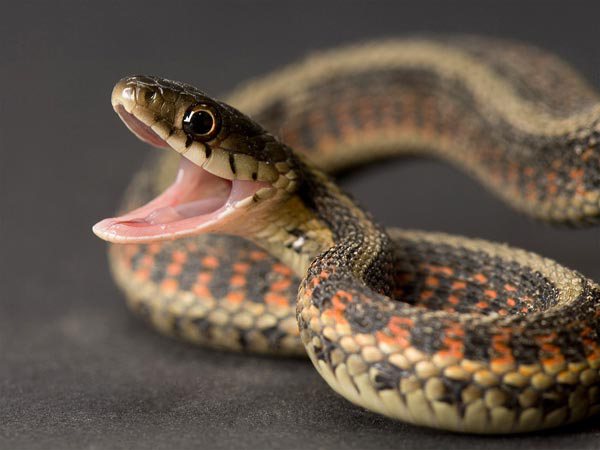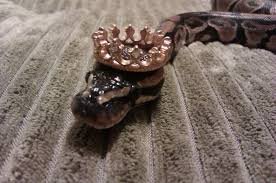

Snakes are elongated, legless, carnivorous reptiles of the suborder Serpentes. Like all squamates, snakes are ectothermic, amniote vertebrates covered in overlapping scales.

Scientific name: Serpentes
Lifespan: Acrochordus arafurae: 9 years
Higher classification: Ophidia
Rank: Suborder
Length: Barbados threadsnake: 10 cm, Acrochordus arafurae: 2.5 m
Diet: Carnivore

뱀은 조상 Serpentes의 길쭉한 다리가없는 육식성 파충류이다. [2] 모든 squamates 같이, 뱀은 ectothermic, amniote 척추 동물은 겹쳐진 가늠자에서 덮는다. 많은 종류의 뱀이 그들의 도마뱀 조상보다 몇 개의 관절이있는 두개골을 가지고있어서 매우 움직이는 턱으로 머리보다 훨씬 큰 먹이를 삼킬 수 있습니다. 그들의 좁은 몸을 수용하기 위해, 뱀의 쌍을 이룬 장기 (예 : 신장)가 나란히있는 대신 다른 하나의 앞쪽에 나타나고, 대부분 하나의 기능적 폐가 있습니다. 일부 수족은 배설물의 양쪽에 흔적 발톱 한 쌍이있는 골반 거들을 유지합니다. 도마뱀은 팔다리가없는 긴 몸체를 진화하였으며, 수렴 진화를 통해 25 배에 달하는 크게 감소 된 팔다리를 가지고 있으며, 다리가없는 도마뱀의 많은 계통을 만들었다. [3] 무자비한 도마뱀은 뱀을 닮았지만 다리가없는 도마뱀의 몇몇 일반적인 그룹은 눈꺼풀과 외이를가집니다.이 규칙은 보편적이지는 않지만 (Amphisbaenia, Dibamidae 및 Pygopodidae 참조) 뱀은 부족합니다.

살아있는 뱀은 남극 대륙을 제외한 모든 대륙과 대부분의 작은 땅에서 발견됩니다. 아일랜드, 아이슬란드, 그린 랜드, 하와이 군도, 뉴질랜드의 섬들과 대서양과 중부 태평양 해역의 많은 작은 섬들과 같은 거대한 섬들도 예외입니다. 또한 바다뱀은 인도양과 태평양을 통해 널리 퍼져 있습니다. 현재 약 520 종족과 약 3,600 종을 포함하는 20 종 이상의 가족이 인정되고있다. [5] [6] 그것들은 크기가 10.4 cm (4.1 in) 인 작은 스레드 뱀 (snake) [7]에서 길이 6.95 미터 (22.8 ft)의 망상 파이썬 (reticulated python)까지 크기가 다양합니다. 화석 종 Titanoboa cerrejonensis는 12.8m (42ft) 길이였다. [9] 뱀은 아마도 쥐라기 시대에 아마도 수렵 도마뱀이나 수중 도마뱀에서 진화 한 것으로 생각되며, 아마도 가장 먼저 알려진 화석은 143-1697 년 전으로 거슬러 올라간다. [10] 현대 뱀의 다양성은 팔레오세 시대 (66 ~ 56 개월 전)에 나타났습니다. 뱀에 대한 가장 오래된 보존 된 설명은 Brooklyn Papyrus에서 찾을 수 있습니다.

대부분의 종은 독이 없으며 독을 가지고있는 종은 주로 자기 방어보다는 먹이를 죽이고 제압하기 위해 독을 사용합니다. 어떤 사람들은 고통스런 부상이나 사망을 초래할 정도로 강력한 독을 가지고 있습니다. 비 번식적 인 뱀은 먹이를 삼켜 버리거나 수축으로 죽입니다.

snakes are elongated, legless, carnivorous reptiles of the suborder Serpentes.[2] Like all squamates, snakes are ectothermic, amniote vertebrates covered in overlapping scales. Many species of snakes have skulls with several more joints than their lizard ancestors, enabling them to swallow prey much larger than their heads with their highly mobile jaws. To accommodate their narrow bodies, snakes' paired organs (such as kidneys) appear one in front of the other instead of side by side, and most have only one functional lung. Some species retain a pelvic girdle with a pair of vestigial claws on either side of the cloaca. Lizards have evolved elongate bodies without limbs or with greatly reduced limbs about twenty five times indepenently via convergent evolution, leading to many lineages of legless lizards.[3] Legless lizards resemble snakes, but several common groups of legless lizards have eyelids and external ears, which snakes lack, although this rule is not universal (see Amphisbaenia, Dibamidae, and Pygopodidae).

Living snakes are found on every continent except Antarctica, and on most smaller land masses; exceptions include some large islands, such as Ireland, Iceland, Greenland, the Hawaiian archipelago, and the islands of New Zealand, and many small islands of the Atlantic and central Pacific oceans.[4] Additionally, sea snakes are widespread throughout the Indian and Pacific Oceans. More than 20 families are currently recognized, comprising about 520 genera and about 3,600 species.
They range in size from the tiny, 10.4 cm (4.1 in)-long thread snake[7] to the reticulated python of 6.95 meters (22.8 ft) in length,
The fossil species Titanoboa cerrejonensis was 12.8 meters (42 ft) long.[9] Snakes are thought to have evolved from either burrowing or aquatic lizards, perhaps during the Jurassic period, with the earliest known fossils dating to between 143 and 167 Ma ago.[10] The diversity of modern snakes appeared during the Paleocene period (c 66 to 56 Ma ago). The oldest preserved descriptions of snakes can be found in the Brooklyn Papyrus.
Most species are nonvenomous and those that have venom use it primarily to kill and subdue prey rather than for self-defense. Some possess venom potent enough to cause painful injury or death to humans. Nonvenomous snakes either swallow prey alive or kill by constriction.
So, why is Hawaii spared the natural existence of terrestrial snakes?
Consider its position in the world. As the most isolated archipelago on the planet, the only way birds, animals, flowers, insects, reptiles, amphibians—even people—could and can reach Hawaii’s sunny shores is by crossing thousands of miles of open ocean. Plants and animals that have endured—remarkably not many—evolved from such colonizers (animals, plants, seeds, and so on), with startlingly low survival rates. (In general, the University of California reports, an invertebrate “successfully colonized Hawaii once every 70,000 years, a plant once in every 100,000 years, and a bird once in every million years.”) Land snakes, it goes without saying, are patently grounded creatures, who, unlike, say, the Hawaiian Monk Seal, lack the necessary apparatuses to swim or fly across the Pacific. Meaning? The only way snakes could and can arrive in Hawaii is by hitchhiking on a boat—or, yes, on a plane.
Downvoting a post can decrease pending rewards and make it less visible. Common reasons:
Submit
Interesting post, I didn't there weren't any snakes on Hawaii. Tnx for the share!
Downvoting a post can decrease pending rewards and make it less visible. Common reasons:
Submit
Hawaii is paradise in more ways than one. Not only is the weather perennially sublime, but the islands are also literally peaceful—at least when it comes to the animal kingdom.
Endemic flies are flightless. The native spider—fittingly called the Happy Face Spider—is non-poisonous; the cave cricket is blind. Even flora in the 50th state is passive: raspberries are thorn-less, nettles are nettle-less, and mint is mint-less—mint being, of course, an evolutionary strategy to ward off potential hunters.
Does Hawaii have snakes?
But even amid all this natural diplomacy, one of the biggest questions visitors ask is: Are there snakes in Hawaii?
Technically, yes—but not necessarily in the way you’re probably thinking of.
Brahminy Blind Snake
Hawaii is home to the Brahminy Blind Snake, a diminutive black snake that has a penchant for gardens.
Believed to have arrived via potting soil from the Philippines in the 1930s, the Brahminy Blind Snake—otherwise known as the Flowerpot Snake, the Island Blind Snake, and the Hawaiian Blind Snake—looks like an earthworm, feeds on ants and termites, seeks shelter under nests, humus, logs, and leaves, and is, at approximately six inches in length, one of the smallest snakes in North America. And, much like the plants and insects of the islands—products of a place in which there are no natural predators—the Hawaiian Blind Snake is non-venomous, a feature that renders it radically different from its cousins around the world, who—like the Western Rattlesnake of California—are fiercely toxic.
Downvoting a post can decrease pending rewards and make it less visible. Common reasons:
Submit
Downvoting a post can decrease pending rewards and make it less visible. Common reasons:
Submit
That's an answer! Damn, are you an encyclopedia?
Downvoting a post can decrease pending rewards and make it less visible. Common reasons:
Submit
Am always on net
But your upvote matters too
Downvoting a post can decrease pending rewards and make it less visible. Common reasons:
Submit
Downvoting a post can decrease pending rewards and make it less visible. Common reasons:
Submit